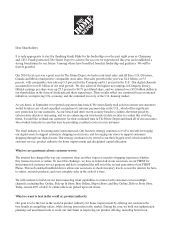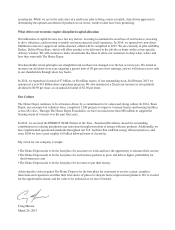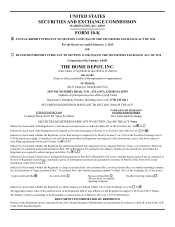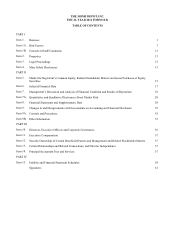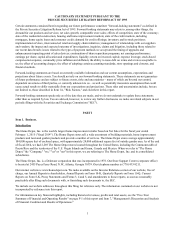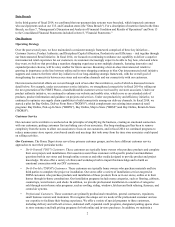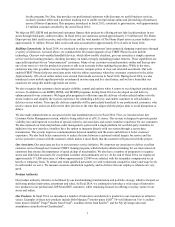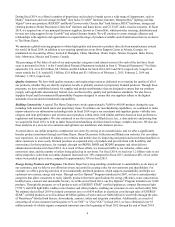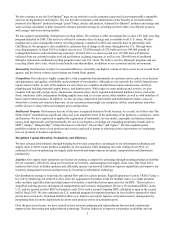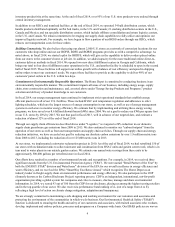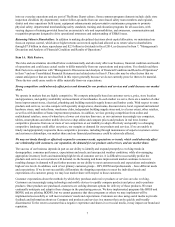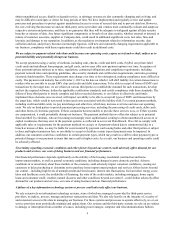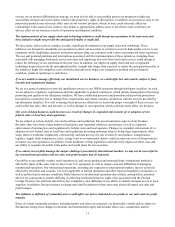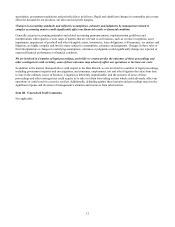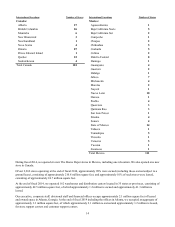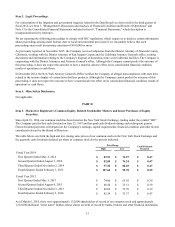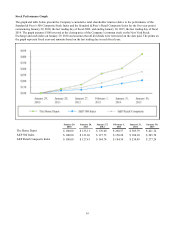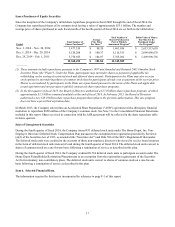Home Depot 2014 Annual Report Download - page 12
Download and view the complete annual report
Please find page 12 of the 2014 Home Depot annual report below. You can navigate through the pages in the report by either clicking on the pages listed below, or by using the keyword search tool below to find specific information within the annual report.7
into our everyday operations and are part of The Home Depot culture. Some common program elements include: daily store
inspection checklists (by department); routine follow-up audits from our store-based safety team members and regional,
district and store operations field teams; equipment enhancements and preventative maintenance programs to promote
physical safety; departmental merchandising safety standards; training and education programs for all associates, with
varying degrees of training provided based on an associate's role and responsibilities; and awareness, communication and
recognition programs designed to drive operational awareness and understanding of EH&S issues.
Returning Value to Shareholders. In addition to making disciplined decisions about capital allocation, we maintained our
focus on expense control, which drove higher returns on invested capital and allowed us to return value to shareholders
through $7.0 billion in share repurchases and $2.5 billion in dividends in fiscal 2014, as discussed in Item 7, "Management's
Discussion and Analysis of Financial Condition and Results of Operations."
Item 1A. Risk Factors.
The risks and uncertainties described below could materially and adversely affect our business, financial condition and results
of operations and could cause actual results to differ materially from our expectations and projections. You should read these
Risk Factors in conjunction with "Management’s Discussion and Analysis of Financial Condition and Results of Operations"
in Item 7 and our Consolidated Financial Statements and related notes in Item 8. There also may be other factors that we
cannot anticipate or that are not described in this report generally because we do not currently perceive them to be material.
Those factors could cause results to differ materially from our expectations.
Strong competition could adversely affect prices and demand for our products and services and could decrease our market
share.
We operate in markets that are highly competitive. We compete principally based on customer service, price, store location
and appearance, and quality, availability and assortment of merchandise. In each market we serve, there are a number of other
home improvement stores, electrical, plumbing and building materials supply houses and lumber yards. With respect to some
products and services, we also compete with specialty design stores, showrooms, discount stores, local, regional and national
hardware stores, mail order firms, warehouse clubs, independent building supply stores and, to a lesser extent, other retailers,
as well as with installers of home improvement products. In addition, we face growing competition from online and
multichannel retailers, some of whom have a lower cost structure than ours, as our customers increasingly use computers,
tablets, smart phones and other mobile devices to shop online and compare prices and products in real time. Intense
competitive pressures from one or more of our competitors or our inability to adapt effectively and quickly to a changing
competitive landscape could affect our prices, our margins or demand for our products and services. If we are unable to
timely and appropriately respond to these competitive pressures, including through maintenance of superior customer service
and customer relationships, our market share and our financial performance could be adversely affected.
We may not timely identify or effectively respond to consumer needs, expectations or trends, which could adversely affect
our relationship with customers, our reputation, the demand for our products and services, and our market share.
The success of our business depends in part on our ability to identify and respond promptly to evolving trends in
demographics; consumer preferences, expectations and needs; and unexpected weather conditions, while also managing
appropriate inventory levels and maintaining high levels of customer service. It is difficult to successfully predict the
products and services our customers will demand. As the housing and home improvement market continues to recover,
resulting changes in demand will put further pressure on our ability to meet customer needs and expectations and maintain
high service levels. In addition, each of our primary customer groups – DIY, DIFM and professionals – have different needs
and expectations. If we do not successfully differentiate the shopping experience to meet the individual needs and
expectations of a customer group, we may lose market share with respect to those customers.
Customer expectations about the methods by which they purchase and receive products or services are also evolving.
Customers are increasingly using technology and mobile devices to rapidly compare products and prices and to purchase
products. Once products are purchased, customers are seeking alternate options for delivery of those products. We must
continually anticipate and adapt to these changes in the purchasing process. We have implemented programs like BOSS and
BOPIS, and are piloting BODFS, but we cannot guarantee that these programs or others we may implement will be
implemented successfully or will meet customers’ needs and expectations. Customers are also using social media to provide
feedback and information about our Company and products and services in a manner that can be quickly and broadly
disseminated. To the extent a customer has a negative experience and shares it over social media, it may impact our brand and
reputation.


